Borghese Gallery – Visit Rome’s Best Kept Secret
Ok, the Borghese Gallery is not exactly a secret to most Romans, but it seldom makes the top 10 list for first time visitors to the Eternal City. That’s too bad, because IMHO it provides a much better experience than visiting the Vatican Museums or St. Peter’s. I’m certainly not advocating skipping those two in favour of the Borghese Gallery, but I am saying that you will come away from a visit to the Borghese in a lot better frame of mind than anything in Vatican City. It all comes down to numbers. The Vatican does not seem to make any attempt to control the number of visitors or their behaviour with the result that there are huge crowds that you have to navigate through with selfie sticks flying everywhere. Also, the seemingly unending number of hawkers trying to sell every type of package possible is a pain. The result is total chaos in front of St. Peter’s Square.
The Borghese Gallery is the complete opposite. It is located inside the largest urban park in the older part of Rome. Walking to and from the gallery through the gardens, with its pools, statues and great views of St. Peter’s, is a very relaxing experience. The Borghese Gallery strictly limits the number of visitors so, while you certainly won’t have the place to yourself, you will be able to enjoy the art at a leisurely pace without having to wait to get to the front of a viewing line for the most popular pieces. You can only buy tickets for specific times in advance so there are no huge lineups. Finally, the Borghese Gallery is just about the perfect size. You can enjoy pretty well all it has to offer in two hours and not come away glassy eyed or thinking that you only scratched the surface. And if you are thinking that maybe it’s this way because there’s not a lot worth seeing, you’d be dead wrong. It has the best collection of Caravaggio paintings and Bernini sculptures on the planet and a lot more to boot.
There are a variety of ways to reserve a ticket, but if you are just visiting on your own, I would recommend using the official website, which thankfully after a long delay has an English version. On the other hand if you want a guided tour, as we did, there are other options. If you google Borghese Gallery you’ll find a whole lot of websites offering tickets and guided tours. I’m sure most of them are just fine, but in light of the very good experience we had, I’m recommending City Wonders and one guide in particular, Angie Militello.
You can book a three hour tour of the Borghese Gallery followed by a walk through the Borghese Gardens to Pincio Terrace for $52.00 USD. For this you get your admission ticket, an audio headset that lets you hear the guide without having to crowd around her and of course, a guided tour. Once you book your specific day and time for your Borghese Gallery tour, City Wonders sends you an email confirmation with the location of where to meet your guide. What follows is my description of our experience having booked and paid online through City Wonders.
Our tour was scheduled to start at 11:00 where we would meet our guide outside (not inside) the entrance to the Borghese Gallery. On our way over to the meeting point from the Lord Byron Hotel where we were staying, I stopped for a chat with Goethe.
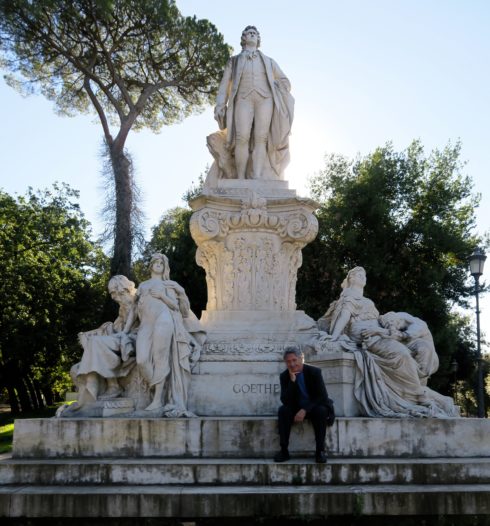
And we gazed across the pond at this replica of the long lost Statue of Zeus at Olympia, one of the seven wonders of the ancient world. It was a great morning for a walk in the park.
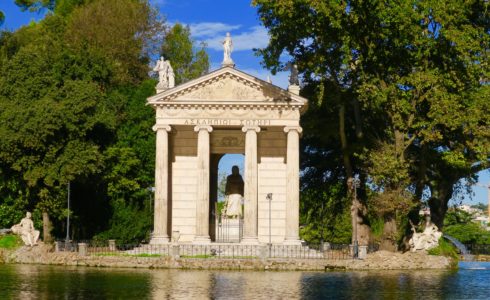
Arriving at the Borghese Gallery we found the forecourt quite full with a lot of what appeared to be high school groups, but before long almost all of them disappeared inside the building. I took this photo and then cropped out the people. As you can see, it’s a nice symmetrical building designed by Flaminio Ponzio in the Mannerism style of architecture so favoured by Michelangelo.
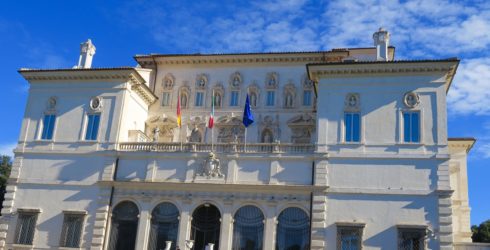
We were a few minutes early so we wandered around to the back where there is a circular pond with this beguiling nymph in the middle.
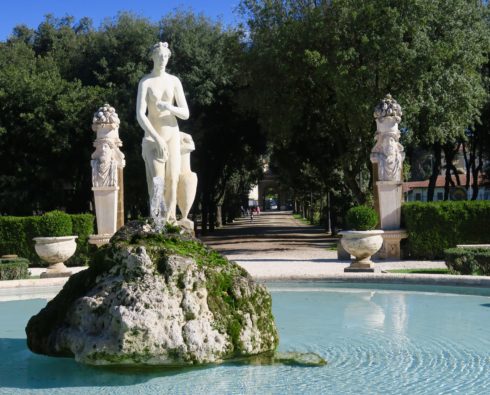
Back at the entrance, our guide, Angie, arrived exactly on time, introduced herself, handed out the tickets and headsets and led us inside.
Borghese Gallery Tour with Angie Militello
There were only seven people on the tour which made it very easy to stick together and not trip over each other. Angie took us aside inside the first room and gave us a run down on the history of the Borghese Gallery collection. Unlike, many guides we’ve had in the past, Angie’s English was perfect – she is in fact an American ex-pat now living in Rome where she teaches in addition to guiding. She also has a sense of humour and clearly loves her work.
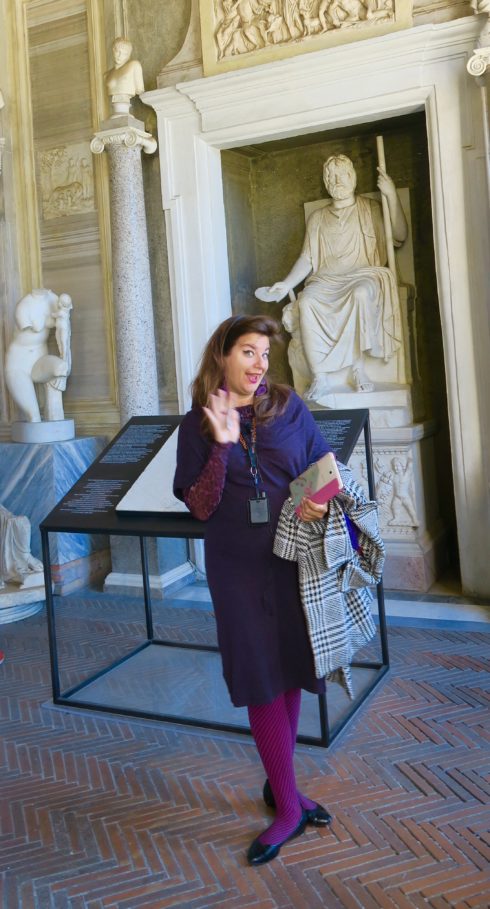
The Borghese Gallery was built as a suburban villa for one Cardinal Scipione Borghese. In those days becoming a cardinal had nothing to do with piety or good works and everything to do with who you were related to. In the case of Scipione, it was his uncle Camillo Borghese who became Pope Paul V in 1605 and promptly put Scipione in charge of just about everything at the Vatican. Scipione was a lover of the arts as well as young men and used to his influence to acquire both over his lifetime. He filled the villa with ancient and contemporary works that made it one of the greatest private collections in the world. He is most noted as being the patron of both Caravaggio and the sculptor Bernini whose works we will be seeing shortly. This is one of two busts Bernini sculpted of his patron which are still in the Borghese Gallery. I don’t think you’d want those lascivious eyes staring at you if you were young, handsome and powerless.
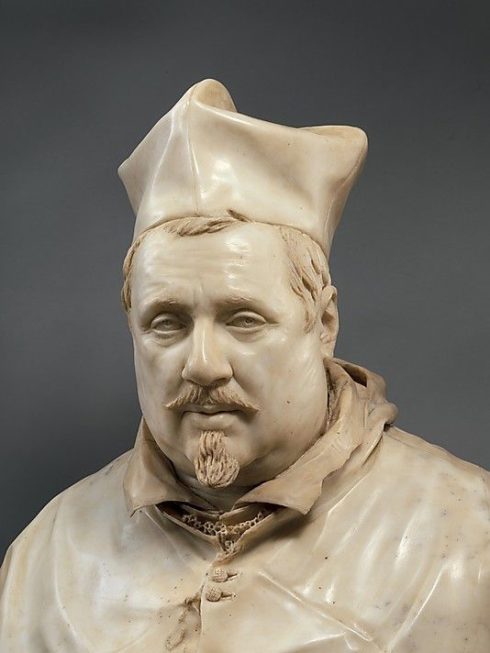
The entry way to the Borghese Gallery contains a very unusual sculpture tied to a Roman foundational myth that I had not heard before hearing it from Angie. This is Marcus Curtius, who according to legend, in 362 B.C. leapt with his horse into a crevice that had mysteriously opened in the Roman forum, after seers declared it would only close after Rome sacrificed its most valuable possession. The crevice dutifully closed up, taking Marcus down to Hades and leaving behind a pit which rapidly filled with water and became known forever thereafter as Lacum Curtius.
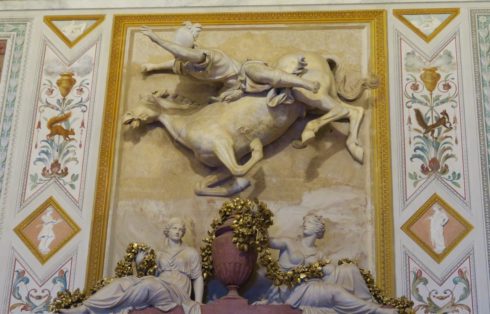
The sculpture is actually a collage. The horse dates back to the second century while Marcus is the 1618 creation of Pietro Bernini, father of the much more famous Gian Lorenzo Bernini. A classic case of the apple not falling far from the tree.
The Caravaggio Room
There are only 20 rooms in the Borghese Gallery (as opposed to 1,400 in the Vatican) and some of them hit you with a visual power that almost borders on breathtaking. Some people do literally gasp when they walk into the Caravaggio Room at the Borghese Gallery, it’s that amazing. Michelangelo Merisi, like many Italians painters of the day including Da Vinci, is better known by the name of the town from which he hailed, Caravaggio, then his proper name. A controversial figure both during his lifetime and thereafter, just about everyone agrees that he ranks as one of the greatest artists of all time with a style that is uniquely his own. I know from the time I first stumbled upon his works in art books at the school library, I was hooked. Caravaggio was the leading exponent tenebrism, a style of painting that uses dramatic contrasts between dark and light subjects; kind of a chiaroscuro on steroids. These are some of his fantastic paintings that are on view in one room in the Borghese Gallery, which permits non-flash photography and has enough light that you can actually get some decent photos of these works.
This is The Sick Bacchus from 1593, one of his earliest paintings, done when he was just twenty-two, but already showing a maturity well beyond his years. There’s something really creepy about this painting (could an immortal god actually drink so much he could make himself sick?) and yet it’s unquestionably brilliant. The eyes have the pleading look of an addict who can’t help himself, but begs for help and maybe forgiveness. It’s actually a self-portrait and apparently done using a mirror during a period that Caravaggio actually was really sick, perhaps with malaria or jaundice. He certainly looks jaundiced.
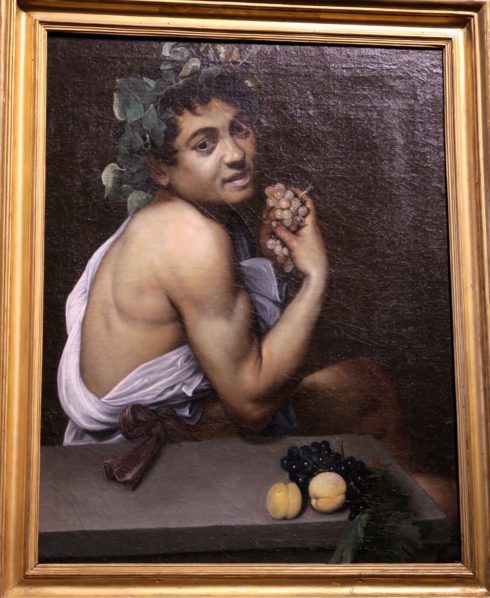
This is Madonna and Child with St. Anne, one of Caravaggio’s religious works that helped keep him in drinking money. The only problem was that he just couldn’t be conventional. Instead of showing St. Anne, Mary’s mother, as a divinely personage, he paints her as an elderly hag. Add to that Mary’s cleavage and Jesus’ uncircumcised little dink and you know why the Vatican was glad to sell it to Scipione just a few years after its completion. Obviously the snake is meant to symbolize evil and Satan, but it reminded me more of the myth of Hercules slaying the snakes Hera sent to kill him in his crib.
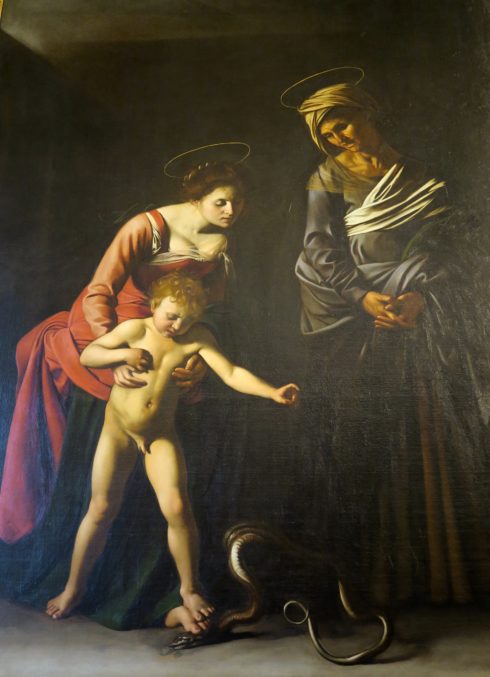
Next we have the astonishingly good St. Jerome Writing. Unlike many early Christian saints, the life of St. Jerome and his works are well documented. A favourite subject for Caravaggio, this work was attributed to the Spanish painter Ribera for almost 100 years. Ribera is good, but not this good.
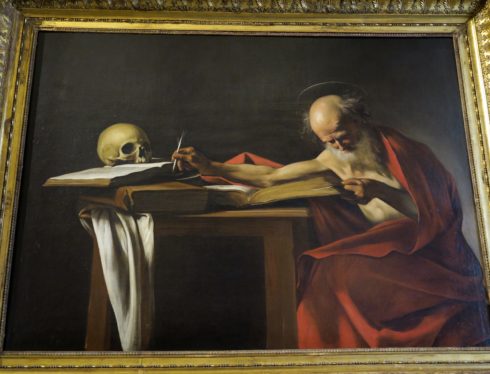
Returning to the self-portraiture mode this is Boy with a Basket of Fruit, except that it’s not Caravaggio, but his friend, 16 year old Mario Minniti who was also an aspiring painter, but alas gained greater fame as a model in many of Caravaggio’s best works. No doubt the obvious homoeroticism must have appealed to Scipione. Gay or not, Mario is an incredibly alluring figure, but leave him out of the picture and you still have a brilliant still life.
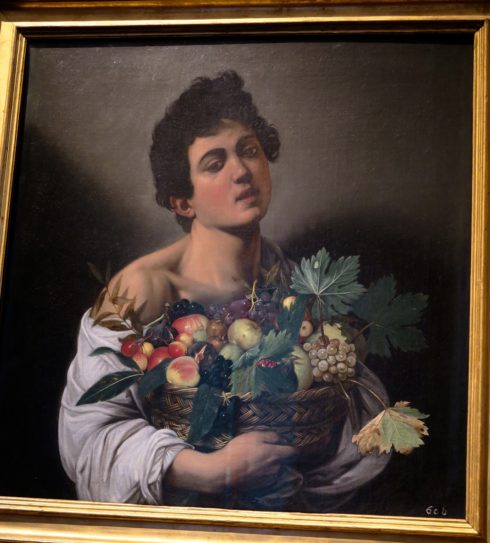
OK, how about we combine the religious with the homoerotic and come up with Caravaggio’s St. John. This is one of his last works and the model for John is looking decidedly Bob Dylanesque.
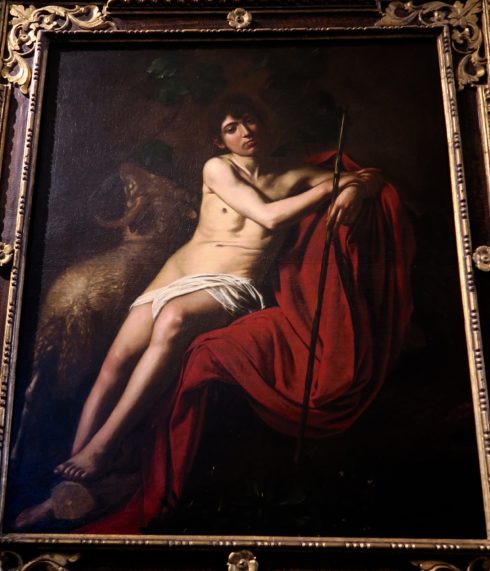
The last Caravaggio in the room is one that I find has a staggering power to it. David with the Head of Goliath features perhaps the same model as the St. John for David, but there is no doubt that Goliath’s head is a self-portrait. The look of regret and faint disgust on David’s face is unique in the hundreds of paintings of this subject. Nothing triumphal here, just the horrid reality of death. Goliath’s face is the thing of nightmares.
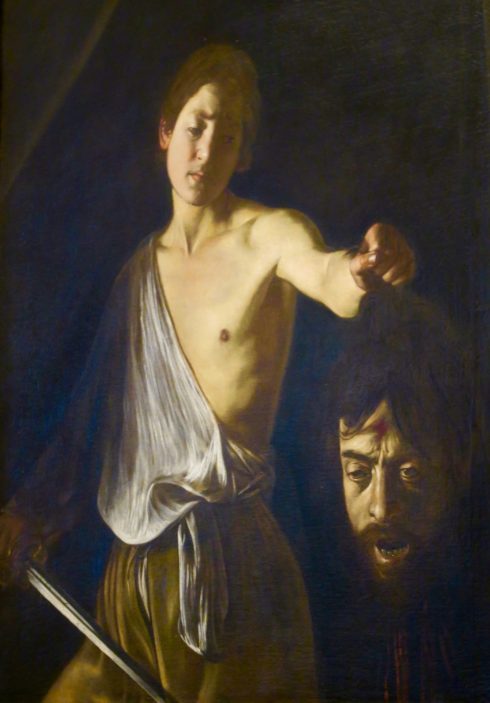
The Egypt Room
Time to move on and view the works of a man who could do with a chisel what Caravaggio could with a paintbrush, but first a stop in Egypt.
The Egypt Room is a feast for the eyes in every direction including straight up where this Allegory of the Nile by Tommaso Conca is the central painting of many that adorn this chamber.
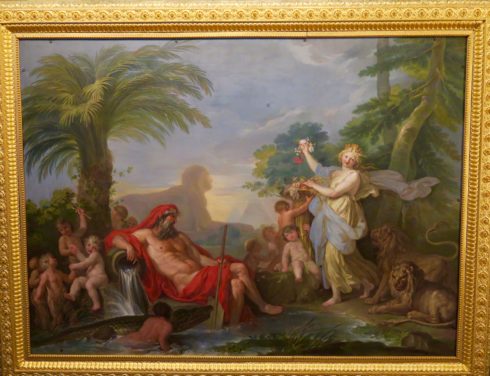
I was particularly struck by this strange figure which is clearly a representation of the jackal-headed Egyptian god Anubis, but he doesn’t have wings. Apparently it is supposed to be the ancient god Uranus who was master of the sky, so old that he was the father of the titans. The falling motion away from the sun must be a reference to the eventual overthrow of the original gods and titans by Zeus and his brothers. I can’t help but think of the myth of Icarus, son of Daedulus, who was given wax wings by his father and promptly had them melt when he flew too close to the sun. Notice the cherubs on the sides that overlap the frame, giving the tromp l’oeil effect that is so much a part of baroque art.
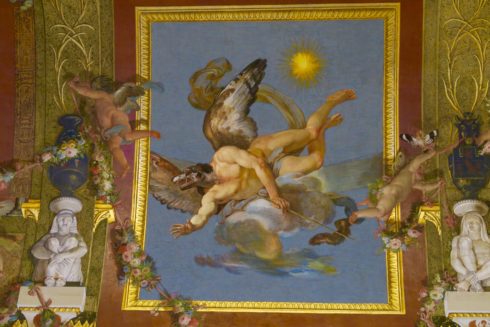
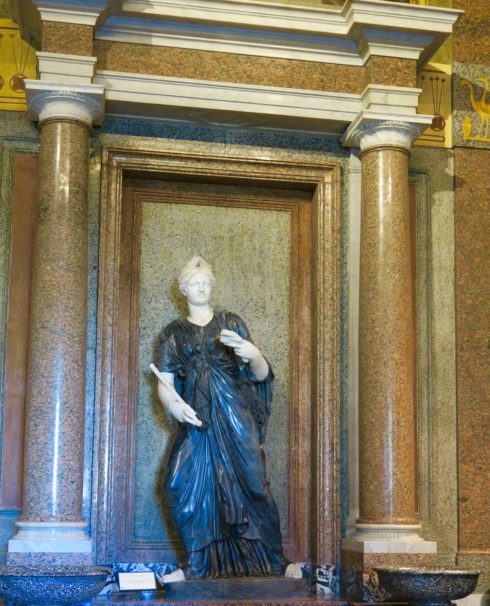
This is a statue of Isis in black Egyptian marble. It was created in the 1600’s by crafting the head, hands and feet onto an existing statue. Recycling is not something that was invented in the 20th century. Artists have been doing it for millennia. The sense of movement in this work is palpable.
Bernini at the Borghese Gallery
Gian Lorenzo Bernini is, to my mind, the greatest sculptor of the modern era and by that I mean since classical times. Probably the last of the great polymaths that included Michelangelo, Da Vinci and Giotto, Bernini could paint, design and build magnificent buildings and monuments, but most of all the guy could sculpt. As noted earlier in this post his father was a sculptor who recognized his sons’ talent exceeded his own from a very young age. Have a look at this sculpture which is on the upper floor of the Borghese Gallery. Bernini did this at age twelve!
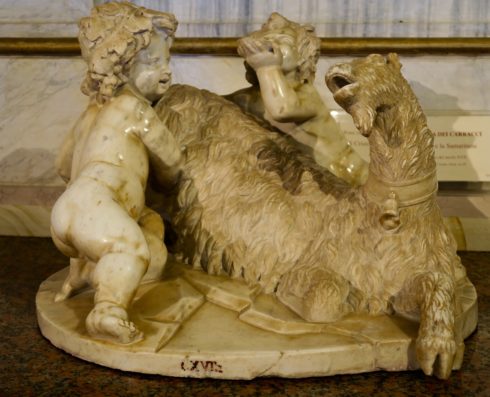
The Borghese Gallery has the best collection of Bernini’s works anywhere and they are displayed in such a manner that you can get a full appreciation of their beauty from all angles. Each of the major sculptures has enough space around it that you can get both a distance perspective and a close up look which is where you really see what a genius Bernini was. This is only possible because the crowds are limited. If these were in the Vatican it would be a mob scene.
So let’s have a look at these great works starting with probably the lesser of the bunch – Aeneas and Anchises.
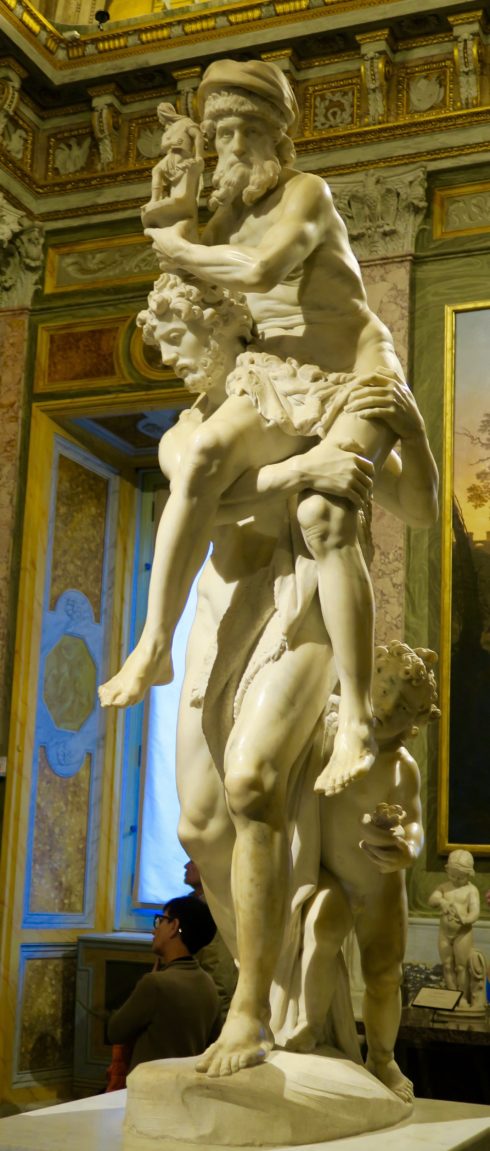
According to Virgil’s epic poem The Aeneid, Rome was founded by the Trojan prince Aeneas who fled the fallen Troy with his father Anchises and son Ascanius. This sculpture is a depiction of that event and at the same time an allegory of the three ages of man. Angie had us look closely at the skin of the three figures and you can actually see baby fat on the boy, muscular sinew on Aeneas and wrinkled skin on Anchises. Anchises never made it to Latium, dying on the way.
The David and Goliath story is one of the most eternal themes in Western art. Almost every great sculptor has tried his hand at David and some have created monumental achievements, most famously Michelangelo’s version in the Galleria dell’Academia in Florence.
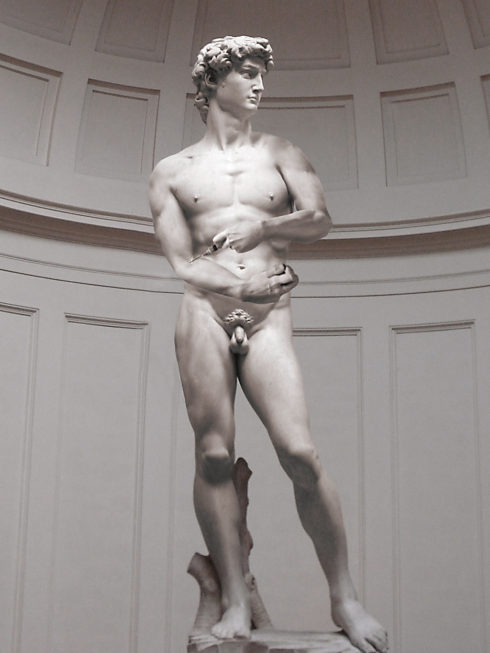
Donatello took a very different approach with his almost effeminate David which you can see in the Bargello in Florence.

Now here’s Bernini’s version.
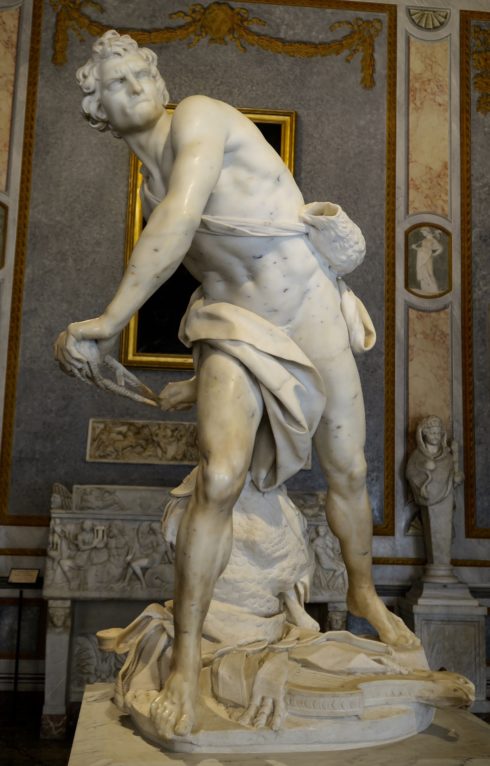
This is the David of action. The look of determination and self will on the face combined with the uncoiling contortion of the body suggests that maybe David is not the underdog he’s supposed to be. And who knew that the entertainer Sting was the model for this David? Just kidding, but it sure looks like him.
Now we come to two of the greatest pieces of sculpture I have ever had the pleasure of viewing, starting with the Rape of Prosperine.
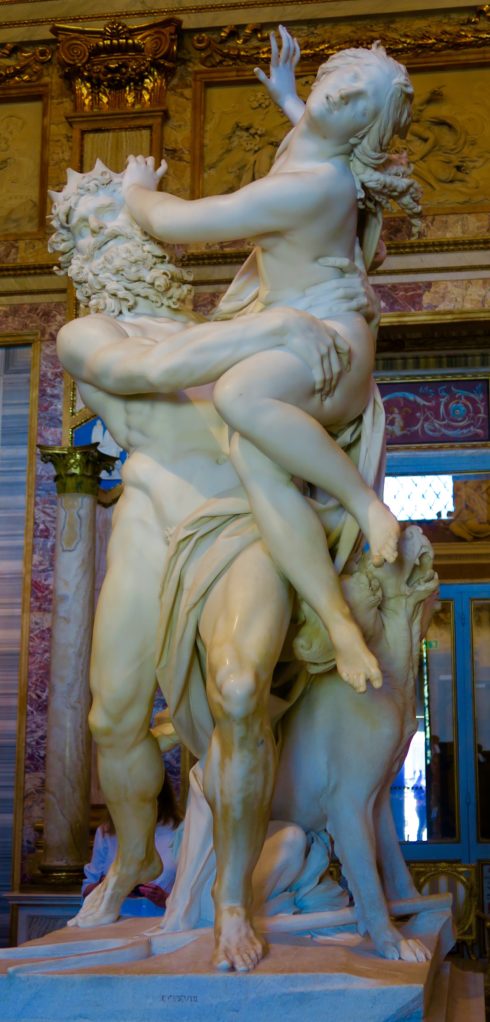
Bernini returned to the classical literature for the story of the Rape of Prosperine (Persephone in Greek) which is one of stories found in Ovid’s Metamorphoses, the best source for many of the most famous myths. Pluto, brother of Jupiter and Neptune, happens upon his niece Prosperine picking flowers and is immediately smitten with her. Losing his head he seizes her and drags her down to his kingdom of the underworld where she becomes his queen. Bernini depicts the scene as the duo arrives at the doorsteps of Hades where Cerberus the three-headed hell hound stands guard. Look closely at where Pluto’s hand is grasping Prosperine’s upper thigh and you can actually see the fingers pressing into the flesh. Unbelievable!
Here is a detail of one of the heads of Cerberus.
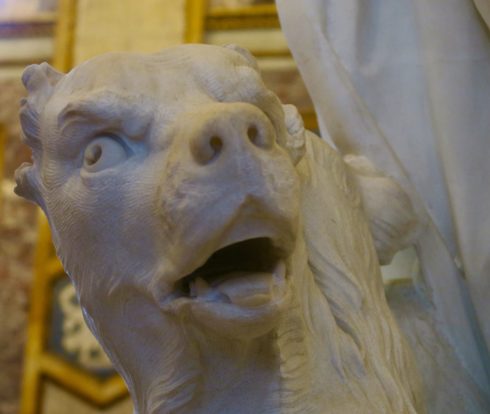
The story of the kidnapping of Prosperine does have a half happy ending. Ceres, her mother and the goddess of fertility was so ticked off by her daughter’s abduction that she refused to let anything grow causing a world wide famine. The gods, worried that there wouldn’t be any people left to worship them, stepped in and arbitrated a settlement whereby Prosperine would return to upper earth for a good part of the year and thus the seasons were born. Spring and the growing season began with the return of Prosperine to visit her mother.
The last Bernini work may just well be the best sculpture ever created by a human being. Turning once more to mythdom Bernini sculpts the story of Apollo and Daphne which goes as follows. Apollo is usually portrayed as one of the ‘good guy’ gods, not a serial rapist like his father Zeus or uncle Hades. So how does he end up chasing down the wood nymph Daphne in a bout of lustful madness? Simple, the little bugger Eros shot him with one of his arrows and made him literally go mad with love for Daphne. Pleading for help from her father, the river god Peneus, to save her virginity, he obliged by turning her into a laurel tree at the very moment Apollo catches up with her. Great story and great inspiration for Bernini. Have a look. Simply amazing.
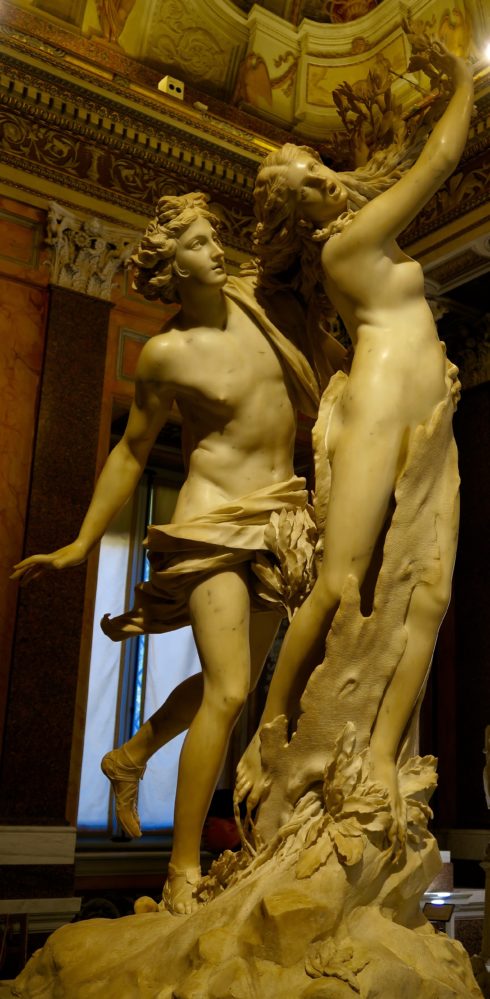
What I would perhaps not have noticed until Angie pointed it out was to look at the statue from behind. The front view shows Daphne clearly as a woman with just her hands and feet beginning to turn. Here is the back view. She’s almost all tree.
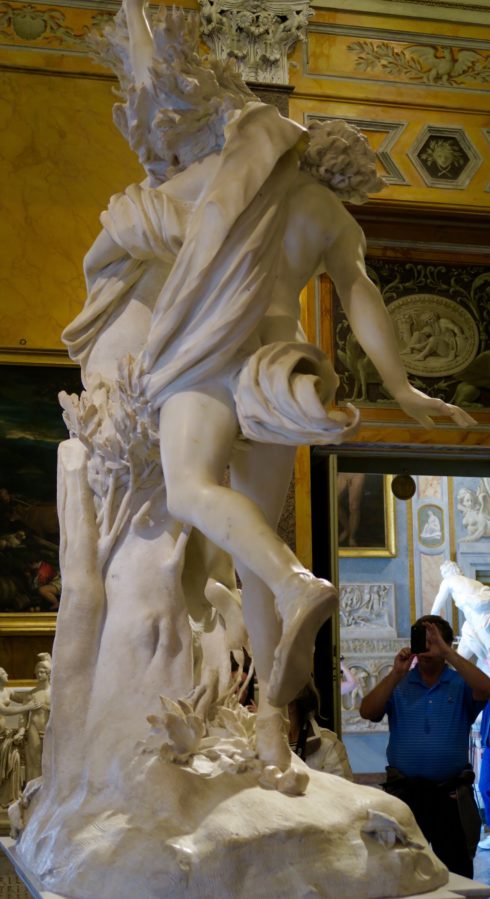
The Bernini statues in the Borghese Gallery are worth traveling to Rome just to see as are the Caravaggio’s, but there’s a lot more to see. Here is just a sample.
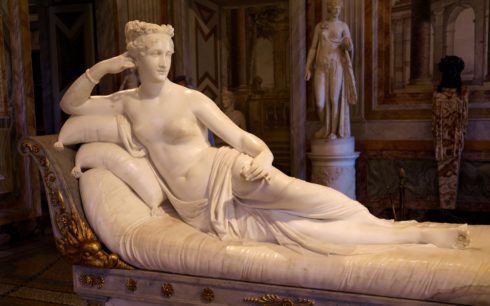
Pauline Borghese, nee Bonaparte, was Napoleon’s youngest sister and according to this link from Scandalous Women, a genuine female debauchee who went through lovers like a sot goes through listerine. She did take the time to pose naked for Antonio Canova, the most famous sculptor of the Napoleonic era and definitely one of the all time greats. Her husband, Camillo Borghese was so embarrassed he hid it in the attic, but today you can look on Pauline in all her naked splendour in one of the best neoclassical sculptures ever made. As with the Bernini’s, Pauline has a room almost to herself and is still the centre of attention she always wanted to be.
This next painting is the only one in this post that is not my own photograph. Don’t know why I forgot to because it’s one of most intriguing paintings in the Borghese Gallery.
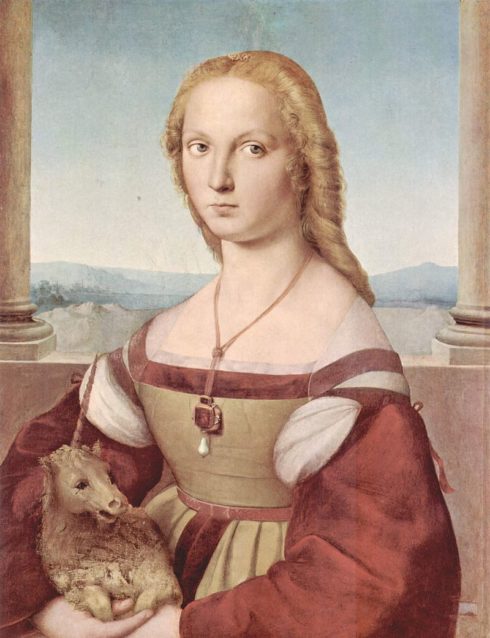
Raphael was at one time as famous as Da Vinci or Michelangelo, but his star has faded a bit, perhaps because the bulk of his work is religious based. However, he was unquestionably a painter of great genius (his monumental School of Athens is reason enough to brave the insanity of the Vatican Museums). I love this painting for two reasons. The first is that it is such an obvious knock off of the Mona Lisa, except for one big difference – those eyes. Whereas Mona’s are beguiling to say the least, this lady’s are suspicious and accusatory. It’s almost like she is asking with her eyes, “What are you staring at?” And the answer is, of course, the second reason I love this painting. She’s holding just about the most adorable little baby unicorn you could imagine. Of course, I’m staring, who wouldn’t.
The unicorn is a symbol of chastity so there’s probably a good reason for her to be holding it. Incredibly, up until 1934, when the painting was transferred from the panel it was originally painted on to a canvas, no one knew the unicorn existed. It had been painted over with the religious symbols of St. Catherine and was thought to be a depiction of that saint.
The last painting I’m going to include in this brief tour of the Borghese Gallery also has an interesting story behind it. This is Titian’s Sacred and Profane Love.
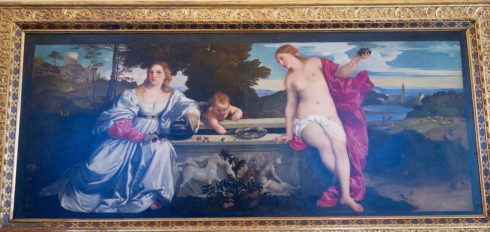
Profane is not a word that we use much in modern speech and when used, it is generally in the context of being disrespectfully irreverent. However it has a simpler meaning which is just the opposite of sacred – secular or non-religious. So which lady represents which? If you’re like me and most people, you guessed wrong. The naked woman has a church and flock of sheep behind her – symbols of religious love. The other lady has a town and two rabbits behind her, and we all know what two rabbits would do.
Angie explained this to us and told another story. In the 1800’s Titian was considered to be the greatest artist of the day and this painting the epitome of his brilliance. The Borghese family was offered the then unheard of sum of 4 million lira by the Rothschild family for this single painting, which they refused. Not long after the entire collection and the palace and grounds were sold to the Italian government for less than what they were offered for the one painting.
After we finished the Borghese Gallery tour we took a stroll with Angie to the Pincio Terrace and said our goodbyes.
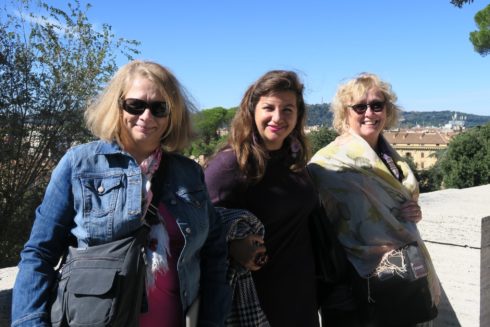
If you would like to book a tour with Angie you can contact her at [email protected]. I hope you enjoyed this tour of Borghese Gallery and hopefully it will inspire you to visit on your own. Ciao from Roma.

